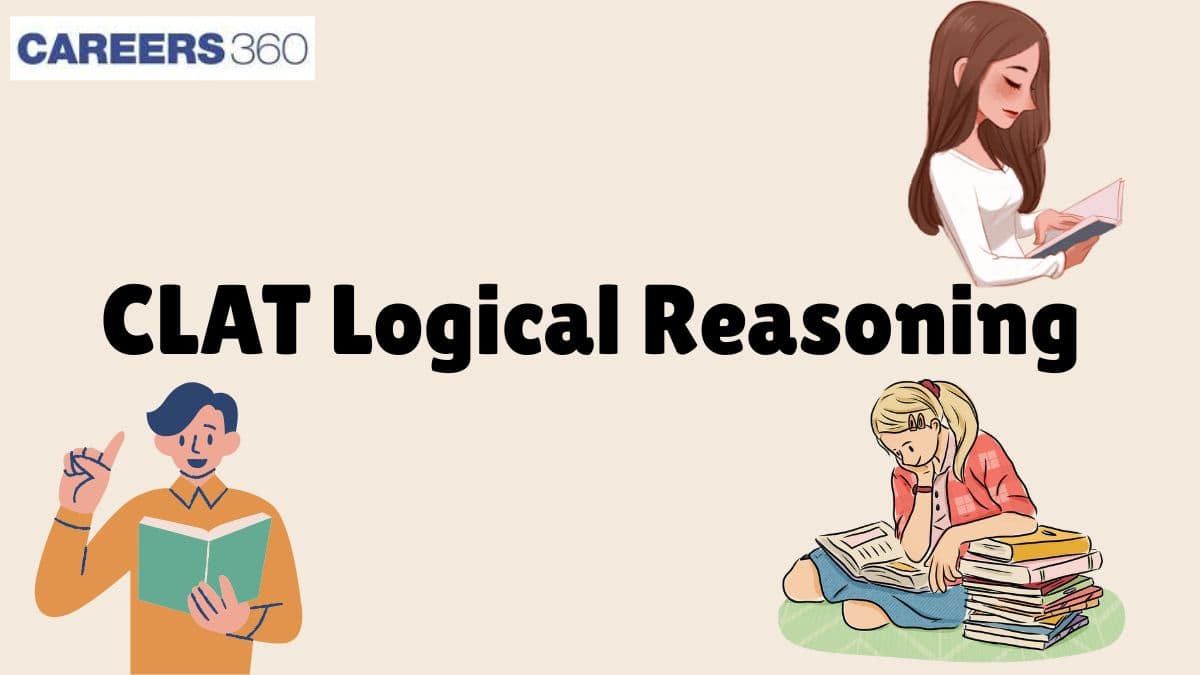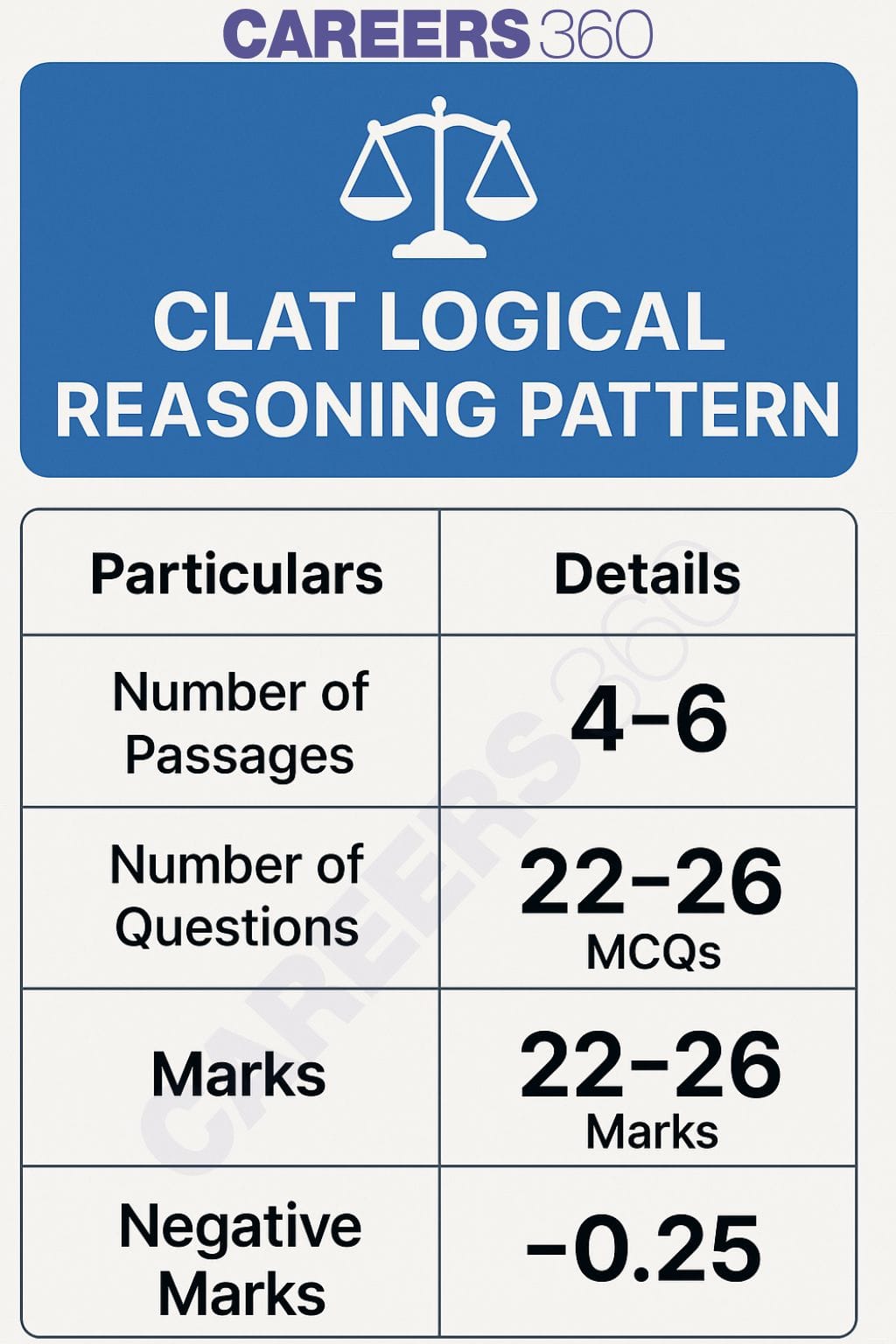Amity University-Noida Law Admissions 2026
Among top 100 Universities Globally in the Times Higher Education (THE) Interdisciplinary Science Rankings 2026
The Common Law Admission Test (CLAT) 2026 exam is scheduled for Sunday, December 7, 2025, from 2:00 pm to 4:00 pm, conducted in a single offline session. The CLAT exam comprises 120 multiple-choice questions with subjects including English language, current affairs, legal reasoning, logical reasoning, and quantitative techniques. The CLAT logical reasoning has a 20% weightage and is one of the important components of the CLAT exam. The CLAT logical reasoning syllabus in the Common Law Admission Test evaluates the ability to reason rationally and logically, an essential skill any lawyer must possess as they win cases by presenting logical arguments.
The Logical Reasoning section in CLAT 2026 will comprise short passages of about 450 words each, followed by one or more questions that evaluate critical thinking and argument analysis. The logical reasoning for CLAT 2026 will have 22-26 multiple-choice questions. In order to come on top, the candidates should do their homework well. In this article, aspirants can find all the details, including the important topics in CLAT logical reasoning, question patterns, and the best books. So, continue reading below.

The logical reasoning for CLAT 2026 is the section that requires the candidate to apply critical thinking and rational thinking to delve into a situation in the problem statement, identify underlying assumptions, and draw conclusions from it.
The number of CLAT logical reasoning questions varies between 22 to 26 as per the revised pattern. The logical reasoning section has a 20% weight in the overall CLAT paper. This section comprises 4 to 6 passages that are around 300 words long and include MCQs based on the passage. The passages in the CLAT logical reasoning sections are extracted from editorials in popular newspapers such as The Telegraph. They could also be drawn from articles in popular magazines.
| Particulars | Details |
|---|---|
Number of Passages | 4-6 |
Number of Questions | 22-26 MCQs |
Marks | 22-26 Marks |
Negative Marks | -0.25 |

The questions will test the candidate’s ability to do the following:
Identify an argument, its presumptions, and inferences.
Quickly framing an argument after reading the passage
Finding patterns in reasoning and understanding how a change in a premise can change the conclusions drawn from it.
Draw conclusions from the passage and apply them in fresh contexts.
Establish linkages and analogies, look for inconsistencies and equivalents, and evaluate the persuasiveness of arguments.
Also check - CLAT English Language
Given below are a few important topics included in the logical reasoning section for CLAT
Drawing Analogies: It involves comparing two situations and understanding their similarities.
Statements and Drawing Conclusions: It involves drawing inferences from a given set of statements
Statements and Making Assumptions: It deals with identifying the likely result by making certain assumptions about a given situation
Identifying Cause and Effect Relationships: It involves determining the underlying factors that led to a particular situation or result.
You may also check
Here is a list of some good books for CLAT 2026 logical reasoning
| Books |
|---|
| Verbal and Non-Verbal Reasoning by RS Aggarwal |
| Analytical Reasoning by M.K. Pandey |
| Logical and Analytical Reasoning by A K Gupta |
Among top 100 Universities Globally in the Times Higher Education (THE) Interdisciplinary Science Rankings 2026
Ranked #18 amongst Institutions in India by NIRF | Ranked #1 in India for Academic Reputation by QS Rankings | 16 LPA Highest CTC
Here are a few simple preparation tips for the logical reasoning section in CLAT 2026
Also check - How to Prepare for CLAT Logical Reasoning
While knowing the content of the syllabus is important, what will take the candidates over the line is continuous practice. So, knowledge of what the paper will look like becomes important. Practising with sample papers helps the candidates replicate exam like situation in terms of time pressure, and this improves speed. It also gives an accurate measure of the level of one's preparation. It can be done by getting hold of CLAT exam sample papers.
In a bid to familiarise the candidates with the CLAT exam pattern, the Consortium of National Law Universities publishes sample papers that can be downloaded from their official website. Another essential aspect of preparing for the CLAT exam is to practise CLAT previous year’s question papers.
You may also read
Here’s a sample passage drawn from the logical reasoning section of the CLAT 2025 question paper, followed by a few questions. It will give a clear idea about what to expect in the exam.
Being a consultant, your work consists of a deep examination of the company’s environment and its internal system to notice inefficiencies and potential improvements. The interaction with the company’s management and different sections to decipher their objectives, opportunities, and processes. This means that, through the use of data analysis, industry best practices, and the formulation of creative ways of solving all problems, to come up with unique solutions to all problems to increase efficiency and productivity, and hence, increase profitability for employers. This might entail operations such as logistics redesign, business process reengineering, adopting new applications, systems, or even community relations programs. People management is a critical component of change management, to make sure that all the relevant parties interpret the potential alterations positively. Also, to offer orientation and create resources to explain the changes to the group and make it comfortable with the shift. The general goal is the organisation’s ability to continue to grow and remain relevant with the shareholders and stakeholders in the industries it operates.
Q. What is the primary responsibility of you being a company’s efficient consultant?
(A) Analysing the organisation’s structure, processes, and market position
(B) Managing daily operations
C) Hiring new employees
(D) Conducting maintenance
Q. With whom does a consultant work closely to understand a company’s goals and challenges?
(A) Customers
(B) Higher management and various departments
(C) External vendors
(D) Competitors
Q. Imagine yourself as a consultant and find what methods you will use to develop customised solutions?
(A) Intuition and guesswork
(B) Social media trends
(C) Random selection
(D) Data analysis, industry best practices, and innovative strategies
Q. Which of the following might a consultant optimise to improve company efficiency?
(A) Office decoration
(B) Supply chain management
(C) Employee dress code
(D) Lunch menus
Q. Why is communication the most relevant thing for a consultant?
(A) To ensure all stakeholders understand the proposed changes
(B) To organise consumer meets
(C) To update the company website
(D) To manage the human resources
Q. What additional support might a consultant provide to help the team adapt to new processes?
(A) Planning a retreat for the team members
(B) Training and support
(C) Personal counselling
(D) Mental Health programs
Also, check -
Frequently Asked Questions (FAQs)
The logical reasoning section in the Common Law Admission Test contains passages usually drawn from newspapers followed by questions that test the candidate’s ability to reason critically, form arguments, and identify relationships and analogies between different situations and implications thereof.
There are 28-32 questions in the Logical Reasoning section which is roughly 20 percent of the total number of questions in the exam.
A lot of materials are available to practise and develop proficiency in logical and reasoning thinking. Candidates can refer to previous year official question papers, sample papers released by the Consortium, or practise using CLAT English mock tests.
There are a lot of books on the subject. A Modern Approach to Logical Reasoning by R.S. Agarwal and Analytical Reasoning by MK Pandey are some books you can refer to.
On Question asked by student community
With an AIR of 34724 and OBC category rank of 7153, chances of getting a seat in DSNLU Visakhapatnam are low in early rounds. However, since you are already invited for counselling, there may be some chance in later rounds depending on seat vacancy and cut-off movement. You should participate
With a CLAT LLM rank of 13656, getting a top NLU is difficult. You may have chances in lower-ranked NLUs or private law universities, depending on seat availability and category.
You can check CLAT LLM counselling details here:
https://law.careers360.com/articles/clat-llm-cut-off
Hello there,
Having a 15000 general rank and 1740 as your SC category rank, your chances of securing a seat are very low. As per the previous trends, it is a direct no for you to get into the top-tier NLUs since the closing general rank is around 1500-3000. If
With a CLAT PG rank of 1257 in the SC category and being a woman candidate with Rajasthan domicile, you do have a realistic chance of securing admission to several National Law Universities, though the top NLUs may be difficult at this rank. Admission chances depend heavily on category-wise cut-offs,
With a CLAT PG rank of around 11,000, getting admission into the top National Law Universities (NLUs) is not likely, as their general category cut-offs usually close much earlier. However, you still have realistic chances in lower-ranked and newer NLUs, especially in the later rounds of CLAT counselling or through
Among top 100 Universities Globally in the Times Higher Education (THE) Interdisciplinary Science Rankings 2026
Ranked #18 amongst Institutions in India by NIRF | Ranked #1 in India for Academic Reputation by QS Rankings | 16 LPA Highest CTC
AICTE & UGC Approved | NAAC A+ Accredited
NAAC A++ Approved | Curriculum Aligned with BCI & UGC
India's Largest University | BCI approved | Meritorious Scholarships up to 5 lacs |
Integrated Learning – A balanced blend of management and legal education